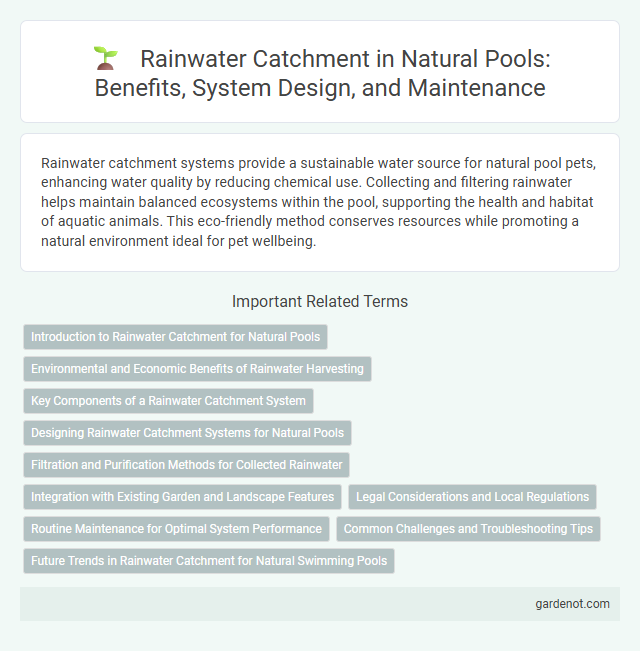Rainwater catchment systems provide a sustainable water source for natural pool pets, enhancing water quality by reducing chemical use. Collecting and filtering rainwater helps maintain balanced ecosystems within the pool, supporting the health and habitat of aquatic animals. This eco-friendly method conserves resources while promoting a natural environment ideal for pet wellbeing.
Introduction to Rainwater Catchment for Natural Pools
Rainwater catchment systems for natural pools collect and store precipitation to maintain water levels sustainably while reducing reliance on external sources. These systems typically include rooftop collection, gutters, and storage tanks designed to filter and channel rainwater directly into the pool. Optimizing rainwater catchment enhances ecological balance and supports the pool's natural filtration processes.
Environmental and Economic Benefits of Rainwater Harvesting
Rainwater catchment in natural pools significantly reduces reliance on municipal water supplies, decreasing water bills and conserving freshwater resources. By capturing and utilizing rainwater, these systems minimize runoff, reducing soil erosion and preventing pollutants from entering natural waterways. This sustainable practice supports ecosystem health while offering long-term economic savings through lower water treatment and infrastructure costs.
Key Components of a Rainwater Catchment System
A rainwater catchment system for a natural pool primarily includes components such as gutters, downspouts, and a collection tank designed to capture and store rainwater efficiently. Filtration units and first flush diverters are essential to remove debris and contaminants, ensuring clean water enters the pool. Pumps and distribution piping then facilitate the movement of stored water into the natural pool for ecological balance and water conservation.
Designing Rainwater Catchment Systems for Natural Pools
Designing rainwater catchment systems for natural pools involves optimizing roof surfaces and gutter layouts to efficiently capture and channel rainwater into the pool's filtration and circulation system. Incorporating first-flush diverters and sediment filters enhances water quality by preventing debris and contaminants from entering the pool. Proper sizing of storage tanks and pump systems ensures a sustainable water supply, promoting eco-friendly maintenance and reducing reliance on municipal water sources.
Filtration and Purification Methods for Collected Rainwater
Rainwater catchment systems for natural pools utilize multi-stage filtration methods, including mechanical filters, biosand filters, and activated carbon to remove debris, sediments, and organic contaminants. UV sterilization and ceramic filtration are often employed for purification, effectively reducing pathogens and ensuring water safety. Integrating these advanced filtration and purification techniques maintains optimal water clarity and quality in natural pool ecosystems.
Integration with Existing Garden and Landscape Features
Rainwater catchment systems in natural pools seamlessly integrate with existing garden and landscape features by utilizing permeable surfaces, native plants, and natural contours to direct and filter water efficiently. Incorporating rain gardens, swales, and bio-retention basins enhances water quality while supporting local biodiversity and reducing runoff. Optimizing these landscape elements promotes sustainable water management and ensures the natural pool remains balanced and eco-friendly.
Legal Considerations and Local Regulations
Rainwater catchment systems for natural pools must comply with local regulations governing water rights, health codes, and environmental protection to ensure legal use and safety. Property owners should verify permits and restrictions from municipal authorities regarding rainwater collection and potential impact on natural water sources to avoid legal penalties. Compliance with guidelines on water storage, filtration, and discharge promotes sustainable management and protection of community water resources.
Routine Maintenance for Optimal System Performance
Routine maintenance of rainwater catchment systems in natural pools involves regularly cleaning gutters, filters, and storage tanks to prevent debris buildup and ensure water quality. Inspecting and repairing components like downspouts and seals minimize leaks and maintain efficient water flow. Consistent monitoring and upkeep extend system lifespan and support sustainable pool operation.
Common Challenges and Troubleshooting Tips
Rainwater catchment in natural pools often faces challenges such as debris accumulation, algae growth, and inconsistent water flow due to irregular rainfall. Installing fine mesh filters and regularly cleaning gutters can prevent clogging and contamination. Ensuring proper slope and storage capacity helps maintain consistent water levels and reduces overflow issues.
Future Trends in Rainwater Catchment for Natural Swimming Pools
Emerging technologies in rainwater catchment for natural swimming pools emphasize smart filtration systems that optimize water quality and reduce maintenance. Innovations include integrating IoT sensors for real-time monitoring of water levels and contaminants, enhancing sustainability and user safety. Future trends also prioritize eco-friendly materials and designs that maximize rainwater harvesting efficiency while supporting biodiversity within the pool ecosystem.
Rainwater catchment Infographic

 gardenot.com
gardenot.com